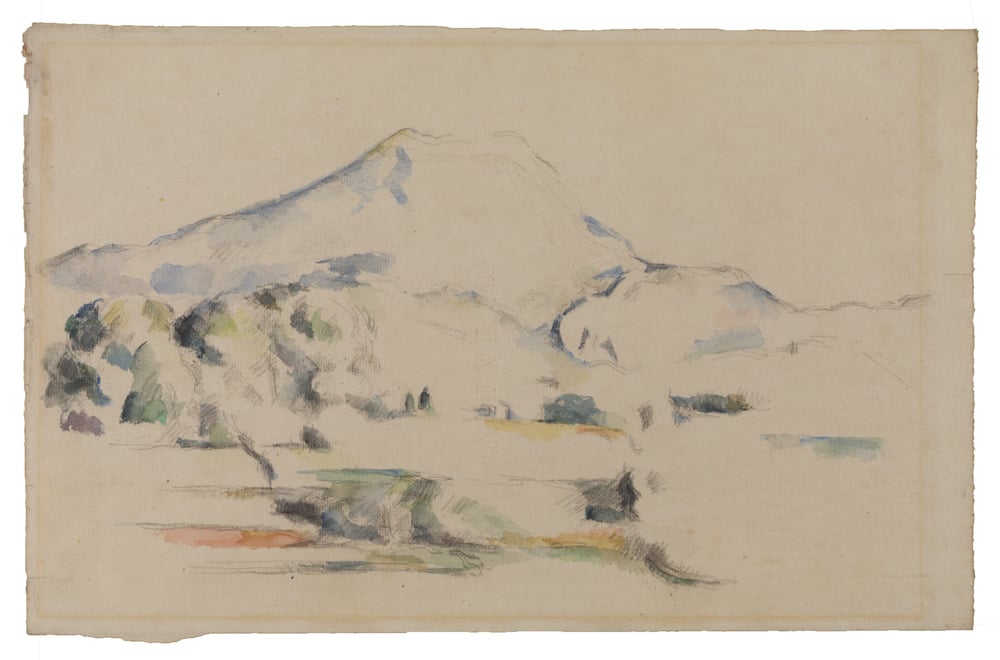
An art historian has discovered a previously unknown link between two landscapes by Paul Cézanne by studying the paper he used 140 years ago. It turns out that the great Post-Impressionist painter sometimes created multiple works on the same large sheet of paper. An exhibition opening in London in the fall will reunite two watercolors painted on the same sheet, displaying them together in public for the first time.
Fabienne Ruppen, an academic and art historian from the University of Zurich, used forensic analysis to research 1,400 of the 2,100 works on paper by the French artist over the past seven years. She spotted a connection between the two paintings by looking carefully at the way their edges were torn.
“Unfortunately, almost no Cézanne drawing or watermark has a precise date,” Ruppen explains. “Even for the ones research has been done on already, we haven’t been able to do more than speculate unless it is of a view he only visited once in his life.”
One of the landscapes shows the Montagne Sainte-Victoire, a French mountain view that he painted throughout his life. The landmark in Provence is the subject of one of the reunited artworks, and its previously unknown partner shows a panorama of a French village, also in Provence.
Ruppen, who has co-curated the show at Luxembourg & Dayan, researched the French paper Cézanne used for his watercolors and drawings. She determined that he would have bought a whole pile of sheets at once from a specialty store. Identifying the same kind of paper and watermark can help reveal which works he executed around the same time. The scholar spent years studying his works in Europe and the US to figure out how the papers were originally connected.
She examined paper quality, watermarks, and traces such as stains or tears from bindings. Whereas previously Cézanne’s work had been separated into large groupings, such as watercolors, pure graphite, and drawings, the new research into paper enabled Ruppen to begin to rematch previously unconnected works.
Paul Cézanne, Paysage en Provence (1885-86). Private Collection. Photo by Elmer de Haas.
Two Parts of the Same Puzzle
The eureka moment came when Ruppen noticed the similarity between the torn edges of the two works, which were like two puzzle pieces waiting to be reunited. “It was that characteristic shape that made me connect the two of them,” Ruppen explains.
These two watercolors are at the center of the exhibition “Reconstructing Cézanne,” on view October 2 through December 7 at Luxembourg & Dayan in London. One of them, La Montagne Sainte-Victoire is on loan from London’s Courtauld Institute of Art, and the other, Paysage en Provence, comes from a private collection. The Courtauld’s curator of drawings, Kelly Gottardo, said in a statement that she is “thrilled” about finding the perfect match to its watercolor.
“Because they don’t show the exact same view, there has never been a direct comparison between them,” Ruppen says. “It is important to look at them closely as a pair and see if there are parallels we have overlooked so far.”
Her research has also established another previously unknown connection between these two landscapes and studies Cézanne made for a series of card players. “At first glance you wouldn’t think they were related but now, looking with this new information, you can figure out parallels in the palette, as well as other formal questions.”
Paul Cézanne, Le Jardin des Lauves: vue sur Aix et la Cathédrale de Saint-Sauveur (1902–06). Private Collection. Photo by David Allison.
The exhibition will be a special occasion for Ruppen—though she traveled back and forth between collections while researching the connection between the two works on paper, she has not yet seen them side by side.
A total of ten works are due to be featured in the show, including a number of loans from private collections, as well as other institutional loans from the Ashmolean Museum in Oxford, the Fondation Beyeler near Basel, and the Musée Granet in Aix-en-Provence. “I think it’s a testament to how relevant the research is, and how exciting these discoveries are, that we have been able to secure loans from institutions that don’t normally lend these works,” gallery partner Alma Luxembourg, who co-curated the show with Ruppen, tells artnet News. “I really feel it is down to this fantastically eye-opening research.”
The show is accompanied by a catalogue, that includes Ruppen’s research, as well as commentary by the author of Cézanne’s new catalogue raisonnée, Walter Feilchenfeldt, as well as the gallerist Karsten Schubert.
“Reconstructing Cézanne: Sequence and Process in Paul Cézanne’s Works on Paper,” October 2 through December 7 at Luxembourg & Dayan in London.